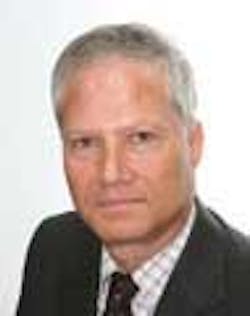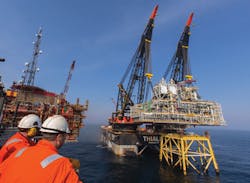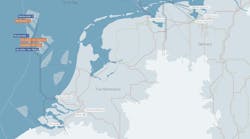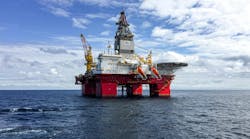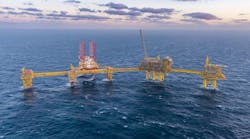Barents studies focus on cost
Statoil has developed a “miniature” subsea template design to improve horizontal drilling efficiency in shallow reservoirs, particularly in high costs areas such as the Barents Sea. Cap-X, unveiled at the recent Barents Sea conference in Hammerfest, northern Norway, is one-quarter of the size of standard templates and could allow expanded operations from a vessel as opposed to a rig, thereby reducing drilling/intervention costs. Statoil adds that the main structure of the technology can theoretically be produced by a larger number of suppliers relatively quickly.
The operator’s main undeveloped asset in the Barents Sea is the Johan Castberg oil field cluster. Earlier this year the company said it had managed to reduce the cost of the planned development from NOK100 billion ($12.33 billion) to NOK50-60 billion ($6.16-7.4 billion), largely through reducing the scope of the offshore infrastructure. According to a recent Reuter’s report, the company is now looking for a further NOK4-billion ($493-million) reduction.
Lundin Norway has set in motion engineering for its first project in the region, commissioning Aker Solutions to undertake a study for an FPSO for the Alta and Gohta oil fields. In addition, the operator has assembled a partnership of EMAS Chiyoda Subsea, Kanfa, Kvaerner, and Xodus to work on concept screening, feasibility and subsea/facilities studies for arctic/sub-arctic area fields off northern Norway.
Platforms in place at Culzean, Montrose
Heerema Marine Contractors has installed the first production structures at two of the UK’s major new offshore field developments, both in the central North Sea. Heerema Fabrication Group’s (HFG) yards in Vlissingen and Hartlepool built respectively the 114-m (374-ft) tall wellhead platform jacket and access deck for Maersk’s high-pressure/high-temperature Culzean gas/condensate project. According to Patrick Put, HFG manager for this project, the base of the jacket, held in place by four pile sleeve clusters, is designed to be twisted 45° with respect to the tower, providing easier access to the drilling rig. The same yards are currently working on the jackets for Culzean’s central processing and utility/living-quarter platforms.
Last month, Heerema’s crane vessel Thialf connected the HFG Zwijndrecht-built 10,500-metric ton (11,574-ton) topsides to the pre-installed jacket, supplied by OGN, for the new bridge-linked platform for the Montrose Area Redevelopment (MAR). The vessel then connected the facility with the existing Montrose platform - in service since the late 1970s - via a new 71-m (233-ft) long bridge, fabricated by Wilton in Teesside, UK.
Operator Repsol Sinopec Resources (formerly Talisman Sinopec) commissioned the new platform to tie in production from the Cayley and Shaw fields as part of a program to produce 100 MMboe of extra reserves from the area, extending the life of the facilities beyond 2030.
In the same sector, Apache has commissioned Subsea 7 and Proserv to provide subsea production pipelines and controls for the recent Callater discovery, which the operator plans to tieback to the Beryl Apha platform.
BP, Statoil award field abandonment work
BP’s Miller oil field in the UK central North Sea ceased production in 2007 after 15 years’ service, but the platform has remained in place, with Petrofac taking care of maintenance, valve, and metering needs over the past four years. Now BP has promoted the contractor to duty holder to manage the facility and to assist evaluation of full decommissioning, with the topsides set to be removed during 2017 or 2018.
Various analysts and industry groups have predicted a surge in UK platform removals over the next decade, and activity is also starting to pick up in the Norwegian sector. Statoil has appointed Heerema Marine Contractors to remove the Huldra gas-condensate wellhead platform in the North Sea in 2019, with AF Offshore Decom to manage the disposal and recycling program the following year at its base in Vats, Norway.
Statoil discovered Huldra in 1982 and started development in 1999, with Aker and Kvaerner constructing the topsides and jacket, each weighing around 5,000 tons. From start-up in late 2001 until shutdown in late 2014, the normally unmanned facility was controlled from the Veslefrikk B semisubmersible platform. Later this year the West Epsilon rig is due to start permanent well plugging operations - decommissioning could continue until 2021.
Repsol, Talisman Energy’s new owner, has commissioned DeepOcean to remove the subsea facilities at the Varg field in the North Sea, which started production in 1998 via a wellhead platform connected to the Petrojarl Varg FPSO. Operations are due to cease this month, with the floater set to leave the field in August, followed by the subsea removal campaign.
Oil price puts brake on Norway drilling
Norway’s undiscovered resources could sustain the country’s oil and gas production for several more decades, according to the Norwegian Petroleum Directorate (NPD). However this might take a while to prove, with the total number of exploration well spuds across the sector set to slump from 56 last year to around 30 this year.
Almost half of the projected 3 bcmoe of oil and gas yet to be found is thought to lie under the Barents Sea, with the remainder split between the Norwegian Sea and the North Sea. NPD is hopeful that some of the future discoveries can enter production from around 2025 onwards.
Despite this year’s downturn, NPD pointed out that 53 companies had interests across the shelf at the end of 2015, close to double the total in 2000, and most are active in the exploration phase. New players, it added, typically bring in ideas for new play concepts, contributing toward a higher discovery rate.
